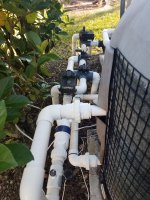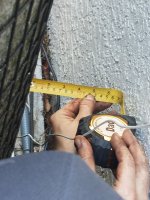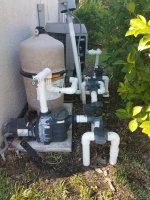My heater is leaking due to age/rust and needs replacement but I'm not sure it's a good idea to replace it without addressing other potential problems with my system. I don't know if these things are issues so I'm hoping someone with experience can give me some advice. It's important to me to get my system running as efficiently/smoothly as possible and I don't mind putting in the DIY to get there.
As it stands now my plan is to:
Here are all the details I'm trying to weigh:
As it stands now my plan is to:
- Remove the shrubs
- Excavate the pvc pipes back far enough to where there has been no shifting/twisting
- Remove the heater and cap the pipes
- Move the concrete slab back to the appropriate spot
- Place the new heater
- Saw couplings off and replace with new piping to the new heater, using the same length of old pipe (should I cut the pipe down instead?)
- I'm going to hire an electrician to wire it up and make sure the subpanel has the proper service for the new unit.
Here are all the details I'm trying to weigh:
- I believe I have 100k now and the spa/pool can be slow to heat sometimes but I doubt my current unit is running near factory CoP. Not sure if I need more BTUs but I want to mitigate my power consumption as much as possible with something like a Heat Siphon Z575HP
- My filter housing is just as old (~15 years)...should I replace this at the same time?
- The concrete pad that the heater sits on appears to have been pushed up next to the house by overgrown shrubs and it only has 6" of clearance from the exterior wall of the house; I believe I'll need to move this away from the house so the heater has 2' (or 3'?) of room to operate properly.
- The pipes close to the overgrown shrubs are cocked at an angle; I'm concerned they're under stress that will lead to a leak eventually.
- The 2hp motor still has life in it but it's a little too powerful (creates back pressure with an extra intake via pool sweep line). Keep or replace?
- Are these shrubs worth saving or are these trunks going to lead to constant overgrowth
- The spa water level goes lower than it should; I want to install a backflow prevention valve while I'm installing the heater. Where is the best place inline to put this?




